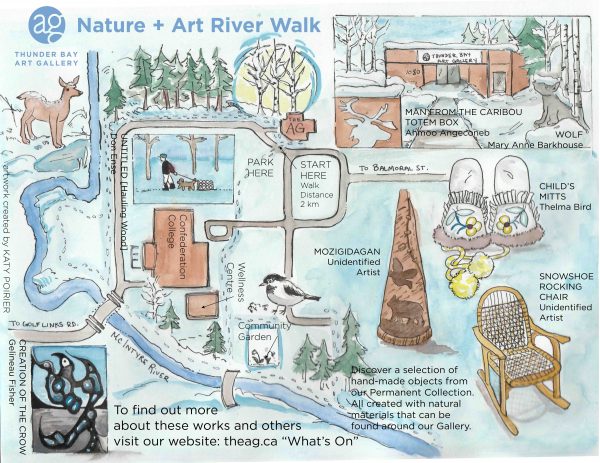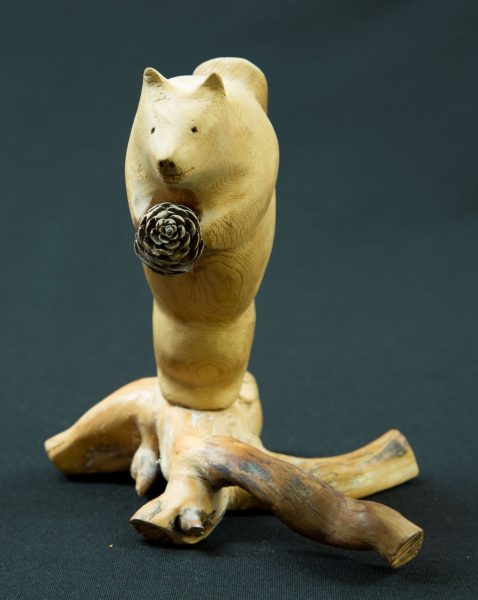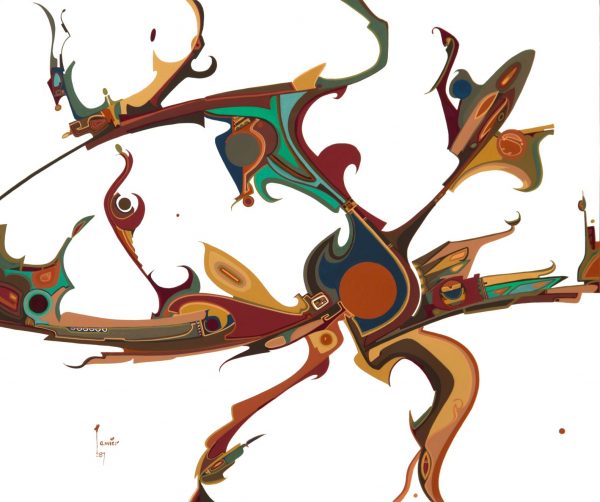Discover a selection of hand-made objects from our Permanent Collection. Many created with natural materials that can be found outside the Gallery.
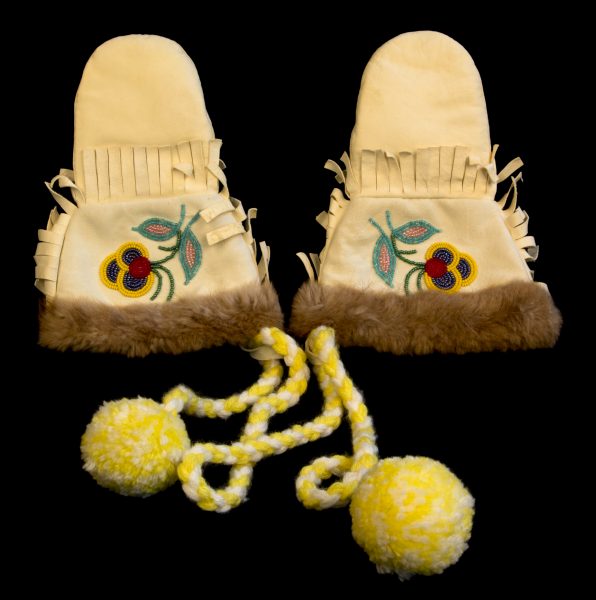
Thelma Bird, Child’s Mitts, c 1980
caribou hide, glass beads, muskrat fur, wool
From Our Hands Collection, Gift of the Ontario Government, 1983
The yellow pompoms on these hide mitts are a burst of color and nostalgia on a cold winter day. Lovingly beaded with Ojibwe florals and trimmed with muskrat fur, these mitts came to the collection as part of the From Our Hands Collection that toured Ontario in the early 80s. There`s cozy felt on the inside.
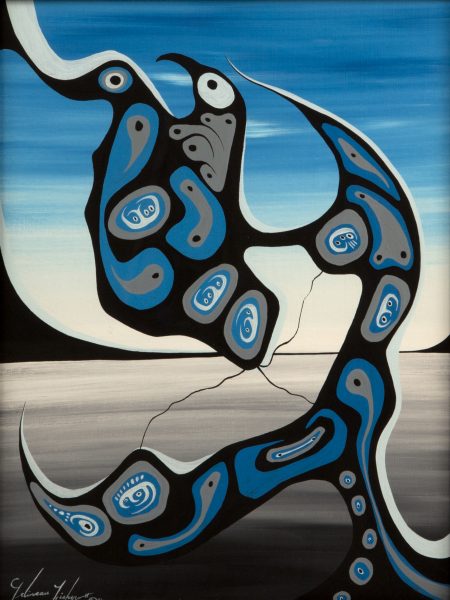
Gelineau Fisher, Creation of the Crow, 1984
acrylic on canvas board
Collection of the Thunder Bay Art Gallery, Waabanda-Iwewin Collection, Ontario Bicentennial Grant, 1984
Gelineau Fisher is known for his fine-lined prints paintings in the genre of Woodland Style. This piece is a departure from his usual style and moves into surrealist territory with swirling and energetic forms. Cool blues and whites create an icy landscape with transformative powers.
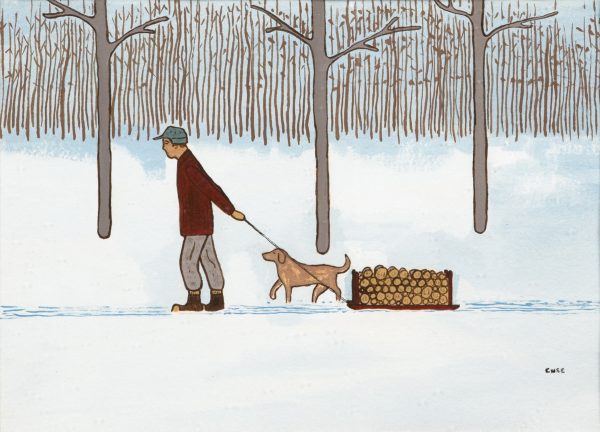
Don Ense, Untitled [Hauling Wood], circa 1978
acrylic on paper
Collection of the Thunder Bay Art Gallery, Gift of L. Bruce Pierce, Norflex Limited, 1994
Painter Don Ense has a knack for the familiar. In this painting, a man hauls wood on a snowy day. The artist evokes an everyday moment, right down to the man’s winter hat. You can almost smell the woodsmoke.
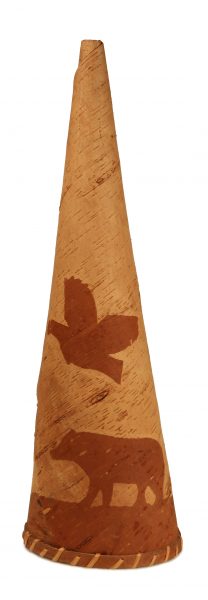
Unidentified Artist, Mozigidagan, circa 1980
birch bark, spruce root
From Our Hands Collection, Gift of the Ontario Government, 1983
“Mooz” is Moose in Ojibwe. This moose caller is decorated with traditional birch bark or wigwas etching technique. The cone form is sewn with spruce root thread. The sound that resonates from birch bark closely mimics the call of a bull moose.
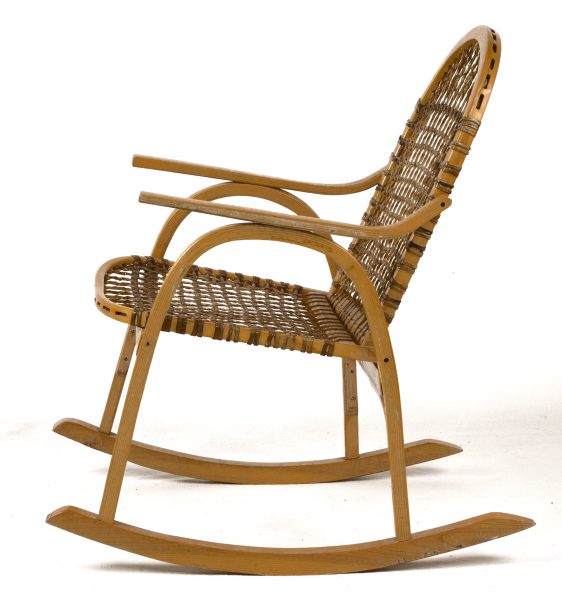
Unidentified Artist, Snowshoe Rocking Chair, c 1980, wood, gut?, varnish
From Our Hands Collection, Gift of the Ontario Government, 1983
A well-crafted chair is a beautiful thing. In the design world, a chair can not only act as a calling card for a designer but can signal an entire era or style movement. Our permanent collection has two chairs full of place, character, and craftmanship. Known as the “snowshoe chairs,” their design combines the practicality and ingenuity of traditional wooden snowshoes.
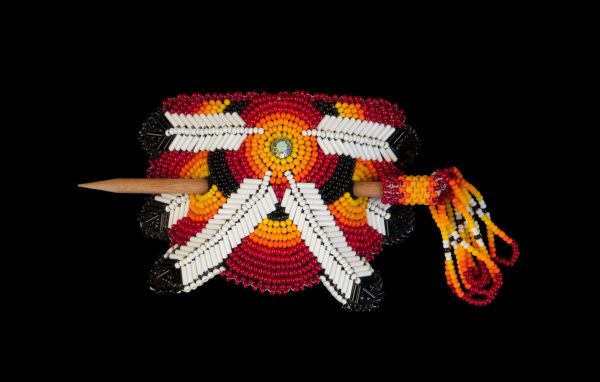
Helen Burning, Barrette, wood, leather, beads, rhinestone, thread, 7 × 18 cm (2 3/4 × 7 1/16 in.)
Collection of the Thunder Bay Art Gallery, From Our Hands Collection, Gift of the Ontario Government, 1985
Helen Burning (b. 1917-1998) was an Onondaga artist from Six Nations near Brantford, Ontario, and a member of the Deer Clan. This richly-coloured “hair stick” barrette, features an ornamental overlay piece with a wooden stick to secure the hair. Helen made beaded adornments and jewelry, including necklaces, hair accessories and head pieces. Bead accessories such as this barrette might have been worn as part of a special outfit, or as part of a woman’s modern style. Today, Indigenous fashion accessories are at the forefront of style, beauty, and reclamation. Helen’s work is also in the collection of the Smithsonian National Museum of the American Indian.
Norman Moonias, Squirrel Holding a Pinecone, wood, pinecone, 14 × 12 × 11.5 cm (5 1/2 × 4 3/4 × 4 1/2 in.)
Collection of the Thunder Bay Art Gallery, Gift of Dan Preley, 2019
A squirrel gathering and stashing pinecones is a sure sign of fall. Norman Moonias (1922-2011) is an Anishnaabe wood carver who started carving in the 1980’s as a hobby. He began by carving small animals and birds, including this extra cute squirrel which he made in 1985. His sculptures reflect traditional ways of life and are mainly of animals and hunting and trapping activities. This little squirrel is perched on a driftwood base and is one of the newest works by Moonias in our collection.
Alex Janvier, Fall Symphony, gouache on paper, 50 × 60 cm (19 11/16 × 23 5/8 in.)
Collection of the Thunder Bay Art Gallery, The Helen E. Band Collection, 1994
Calligraphic lines of brown, ochre, and green swirl and collide in Denesuline and Saulteaux artist Alex Janvier (b. 1935)’s Fall Symphony. Alex proudly credits the beadwork and birch bark basketry of his mother and other relatives as influencing his art. He also credits artists Wassily Kandinsky (Russian) and Paul Klee (Swiss) as inspirations. As a young child growing up in Cold Lake First Nations, Janvier not only observed traditional practices in his community, but also created his own creations using sticks to etch designs onto the Earth. How does this work express the feeling, or experience, of autumn?
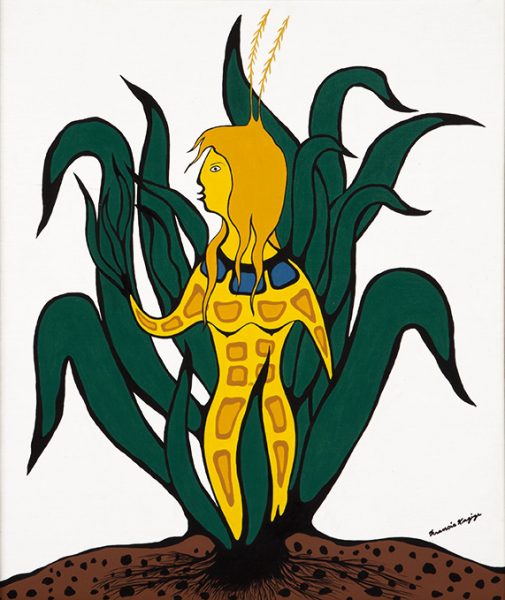
Francis Kagige , Spirit of the Maize, 1994, acrylic on canvas board, 60 x 50 cm, Gift of L. Bruce Pierce, Norflex Limited, 1994
Spirit of the Maize by Anishinaabe artist Francies Kagige (1929-2014) celebrates the bounty of summer. In bold lines and colours of the new Woodland style, Kagige’s works honours the Three Sisters as sacred crops. Maize (corn), winter squash, and climbing beans are the three main agricultural crops of various Indigenous groups across North America. Maize, as Kagige pictures it, is at the very heart of our shared human story.
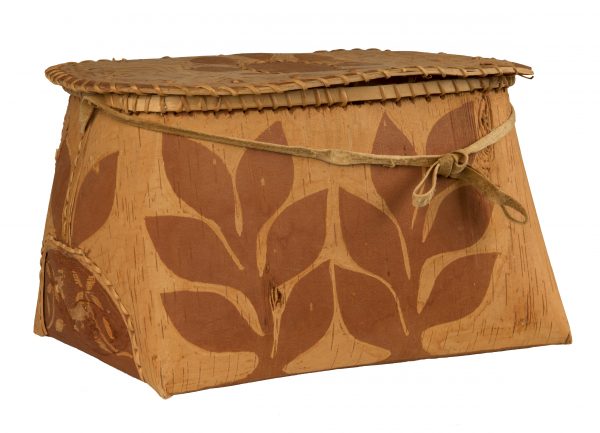
Unidentified Artist Rogan, circa 1980 Birch bark, spruce root, hide 21.6 x 33.1 x 24 cm From Our Hands Collection, Gift of the Government of Canada, 1985.
Birch bark, also known as wiigwaas in Ojibwe, is one of the most important resources used in Indigenous cultures of the Great Lakes region. Birch bark baskets come in all shapes and sizes and were used for daily activities such as storage, gathering berries and hauling water (birch bark is waterproof which is why it makes great canoes). Design and decoration are integral to baskets, with the smoother, golden brown “inside” of the bark often used on the outside of the piece. Late June and early July is typically the time to harvest birch bark, and must be done with care and respect. If done correctly, gathering bark will not cause permanent damage to the tree. Many artists today are continuing this practice.
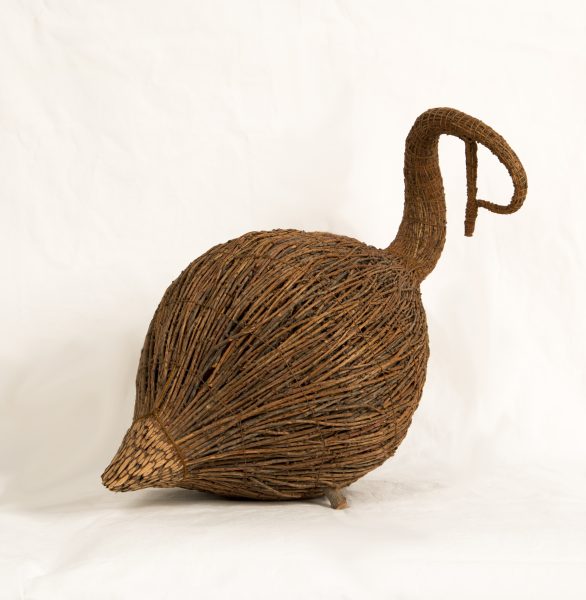
Glenn Small Tamarack Decoy, circa 1980 tamarack, nylon 30.5 x 51 x 27.5 cm From Our Hands Collection, Gift of the Ontario Government, 1985.
The forest near the gallery is filled with Tamarack trees. In Cree heritage, Tamarack decoys are based on lures that were used originally for goose-hunting. A Tamarack Decoy as a souvenir, or art piece, started in 1965 when a Cree man named John Bluejoy began to create small geese sculptures while recovering in the Moose Factory hospital. Today, artists from Moosonee and the James Bay region are renowned for their skill in binding delicate and fragrant tamarack twigs into the likeness of the Canada goose.
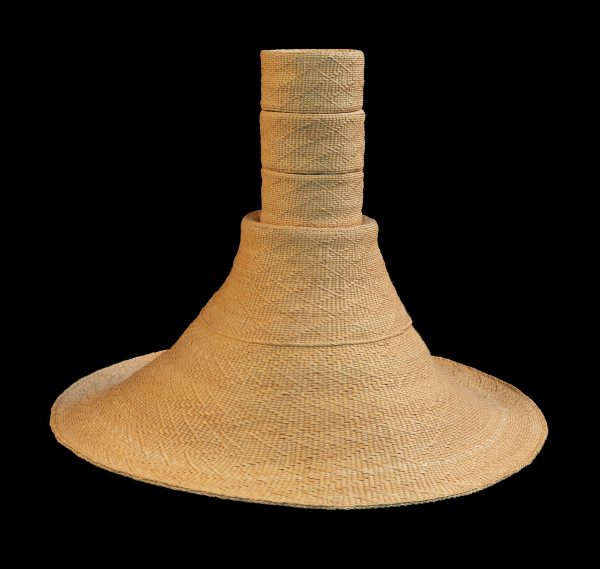
Isabel Rorick, Spruce Root Hat, nd, spruce root, 30 x 38 cm, Gift of Charles Peacock, 1992.
Stop and bend down near a tree root. Did you know spruce roots are used for weaving? Isabel Rorick (b. 1955) is an internationally renowned spruce root weaver born in Old Masset, Haida Gwaii. “I love going into the forest,” she says, “just talking about it makes me excited. Digging the roots… finding a good spot…”. Rorick prepares roots for weaving through a process of cooking and roasting passed down through generations. She weaves all her hats free form, without a set pattern.
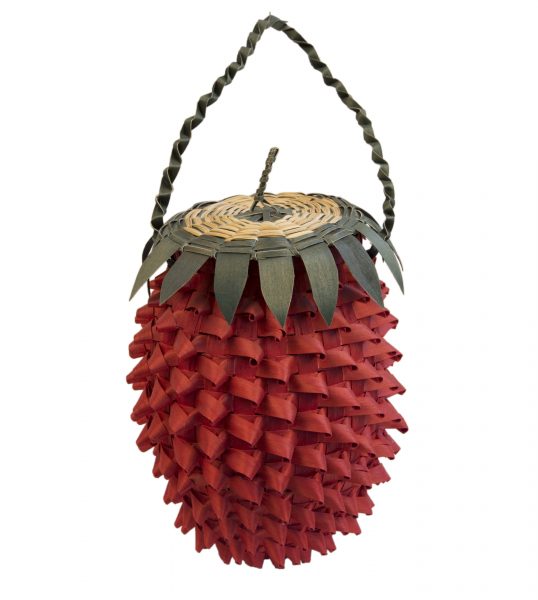
Maime Migwans, Strawberry Basket, c1980, black ash, dye, 5.1 cm diameter, From Our Hands Collection, Gift of the Ontario Government, 1985.
Did you spot our wild strawberry patch? A weaver named Maime Migwans (b. 1925-2000) made this exceptionally sweet berry-shaped basket by delicately curling strips of Black ash. Black ash trees are generally found only along stream banks and the edges of swamps.
Known as Ode’imin or “heart berry,” the wild strawberry is an important plant in Anishinaabe culture. Bursting with flavour, nutrients (vitamin C), and medicinal uses, this hearty little plant was a key source of food and medicine for Indigenous people throughout history. Wild strawberries remain sacred and a source of inspiration for many people today. The plant is a common motif in traditional and contemporary beadwork, quillwork and basketry. The inviting red berries, white flower, and three leaflets appear in art and design throughout North America/Turtle Island.
![Benjamin Chee Chee, Untitled [Family in Flight], 1977, acrylic on paper, 45.7 x 60.7 cm, The Bert Curtis Benjamin Chee Chee Collection, Purchased in 1983.](https://theag.ca/wp-content/uploads/2021/06/1983_11_020_front_whitebackground2-600x451.jpg)
Benjamin Chee Chee, Untitled [Family in Flight], 1977, acrylic on paper, 45.7 x 60.7 cm, The Bert Curtis Benjamin Chee Chee Collection, Purchased in 1983.
Ojibwe Artist Benjamin Chee Chee (b. 1944-1977) is famous for his paintings of Canada geese. His minimalist portraits of the birds are graceful and dynamic. This piece expresses ideas of kinship and captures how geese move through the sky, from north to south and back again.
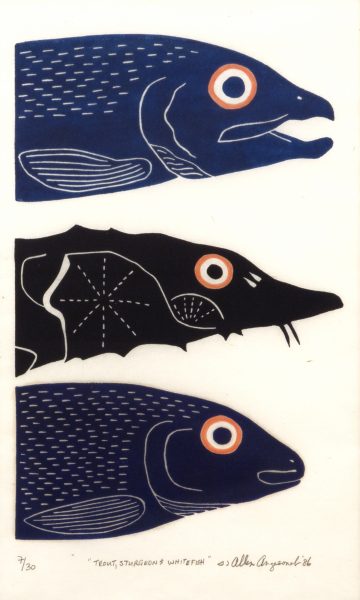
Ahmoo Angeconeb, Trout, sturgeon and Whitefish, 1986, linocut on paper (7/30), 42.5 x 26.5 cm, Gift of L. Bruce Pierce, Norflex Limited, 1994.
Artist Ahmoo Angeconeb (b. 1955-2017) depicts three different species of fish that live in the MacKenzie River Watershed, which includes the Neebing/McIntyre Floodway. In 2015, a stretch of the McIntyre River that flows near Central Ave underwent a restoration project to improve fish habitat. Riverbanks with diverse trees and plants help stop erosion and protect fish spawning areas. In this work, Ahmoo shows us how the mouth, eye and head a fish seem to define its “character.”
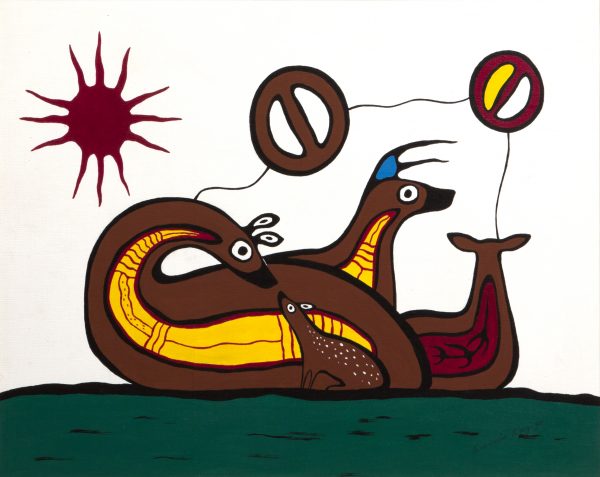
Francis Kagige
Untitled (Deer Family), 1980
Acrylic on canvas board
46 x 61 cm
Gift of Mr. N. C Opperman, 1988.
Deer are visitors to the gallery all year round. Francis Kagige (b. 1929-2014) captures the gentleness of these wild animals by depicting a doe rubbing noses with her fawn. If you wait long enough, a member of our own little deer family is likely to stop by the bird feeder at the back of the gallery. (Please do not approach the deer.)
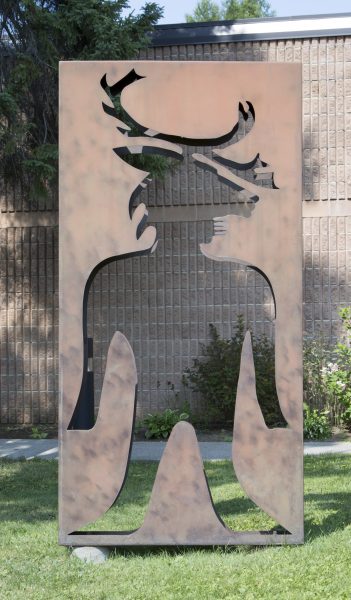
Ahmoo Angeconeb, Man From the CaribouTotem Box, 1995, steel, 234 x 113.5 cm, Thunder Bay Art Gallery Collection, 1995.
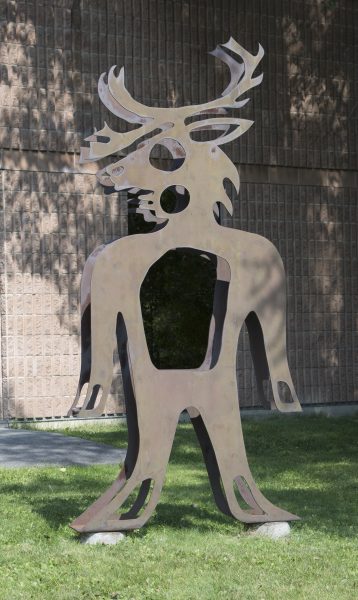
Ahmoo Angeconeb, Man From the CaribouTotem, 1995, steel, 234 x 113.5 cm, Thunder Bay Art Gallery Collection, 1995.
Ahmoo Angeconeb’s (b. 1955-2017) iconic sculptures trick the eye as they greet our visitors. Ahmoo was such a skilled printmaker and sculptor that these works look like they are paper cut outs. Throughout his prolific career, Ahmoo explored Anishinaabe cosmologies with detailed lines and a wide range of colours and imagery. Including this 1995 commission, the gallery has 43 works by the artist our Permanent Collection. As an artist who began his relationship with the gallery in the 80s, we hold a special place for Ahmoo in our hearts.
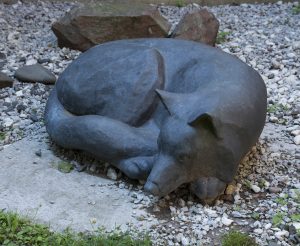
Mary Anne Barkhouse, Wolf, 1999, bronze, 38 x 97 x 66 cm,Purchased with the support of the Canada Council for the Arts Acquisition Assistance Program/Oeuvre achetée avec l’aide du programme d’aide aux acquisitions du Conseil des arts du Canada and funding from the Walter and Duncan Gordon Foundation, 2000.
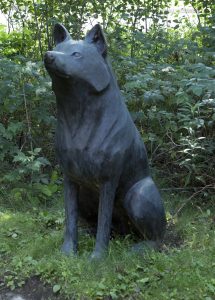
Mary Anne Barkhouse, Wolf, 1999, bronze, 114 x 77 x 78 cm,Purchased with the support of the Canada Council for the Arts Acquisition Assistance Program/Oeuvre achetée avec l’aide du programme d’aide aux acquisitions du Conseil des arts du Canada and funding from the Walter and Duncan Gordon Foundation, 2000.
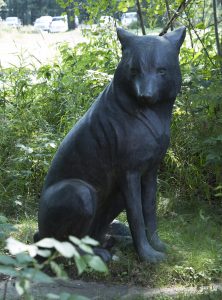
Mary Anne Barkhouse, Wolf, 1999, bronze, 105 x 70 x 60 cm,Purchased with the support of the Canada Council for the Arts Acquisition Assistance Program/Oeuvre achetée avec l’aide du programme d’aide aux acquisitions du Conseil des arts du Canada and funding from the Walter and Duncan Gordon Foundation, 2000.
Three bronze sculptures each titled “Wolf” are nestled in the forest that surrounds the Gallery. Completed in 2000, by sculptor Mary Anne Barkhouse (b. 1961). Each wolf’s canine body language and facial expressions are wise, wary, and dignified. These works are a beautiful reminder that the land is a shared home for many different species. Did you spot all three?
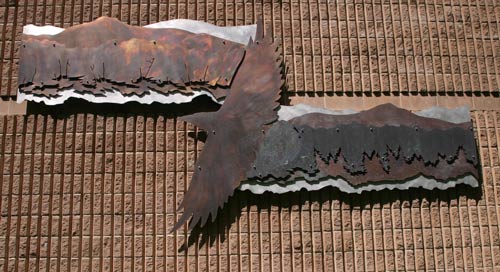
Fireline, 2000
Michael Belmore
Copper, aluminum
288 x 460 cm
Purchased with the support of the Canada Council for the Arts Acquisition Assistance Program/ Oeuvre achetée avec l’aide du programme d’aide aux acquisitions du Conseil des arts du Canada and funding from the Walter and Duncan Gordon Foundation, 2000.
Michael Belmore’s Fireline is installed on the wall of the building just above the picnic table. Three main elements of this copper-toned piece create a layered vista. On the left, the artist’s precise metalwork suggests both twigs and forest shadows or a shoreline with lily pads. As the eye moves right across the linear plane, the imagery morphs into an upside-down treeline. A soaring bird connects these two landscapes. What do you a shifting, textured horizon represents in Fireline?


